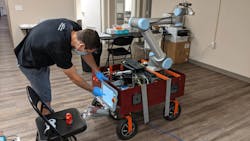Humans are suffering from the global pandemic brought on by COVID-19 virus, but a robot wants to help. A decontamination robot originally designed for shipboard firefighting and maintenance has been modified by university researchers funded by the Office of Naval Research (ONR) to battle against the spread of the COVID-19 coronavirus. The robot (see figure) uses ultraviolet C-range (100 to 280 nm wavelength) UVC light to disinfect surfaces without contact. The robot has four wheels and a mechanical arm to maneuver the UV light source over the surfaces to be treated. The robot requires human operators, but the hope is to transform the design into an autonomous health assistant.
“The value of robots to deploy UVC lamps for decontamination is that you can reduce exposure of humans to the UVC light, and the robot can reposition the lamps over surfaces you wish to decontaminate using its arms,” Dr. Thomas McKenna, a program officer in ONR's Warfighter Performance Department said. “When the robot was designed, there was no COVID-19, but the combination of mobility and manipulation are a good match to this task,” McKenna added.
The ONR has been involved in fundamental research on human-robotic interactions for over 20 years, with the help of small companies, universities (including Virginia Tech and the University of Virginia), and the U.S. Naval Research Laboratory (NRL). The research is motivated not only by the desire to remove humans from dangerous situations, but to have robots perform routine tasks so that sailors and Marines can be freed for other assignments. The initial ONR program in the development of humanoid robots focused on shipboard damage control, such as firefighting and shipboard maintenance.
But with the help of Dr. Tomonari Furukawa, a professor at the University of Virginia, manipulators were added to mobile robots to adaptively position UVC lamps for effective decontamination. “The robot can already disinfect by teleoperation. In August, we tested and successfully demonstrated disinfection of a room of COVID-19 at a testing center while teleoperating from a different building,” Furukawa said. “We are currently developing the ability to build a 3D map showing disinfected surfaces, and possibly infected surfaces, with which we can next introduce autonomous disinfection. Full completion will need much more work, but we are planning to complete the first installation of the mapping capability by the end of this year.”
About the Author
Jack Browne
Technical Contributor
Jack Browne, Technical Contributor, has worked in technical publishing for over 30 years. He managed the content and production of three technical journals while at the American Institute of Physics, including Medical Physics and the Journal of Vacuum Science & Technology. He has been a Publisher and Editor for Penton Media, started the firm’s Wireless Symposium & Exhibition trade show in 1993, and currently serves as Technical Contributor for that company's Microwaves & RF magazine. Browne, who holds a BS in Mathematics from City College of New York and BA degrees in English and Philosophy from Fordham University, is a member of the IEEE.
